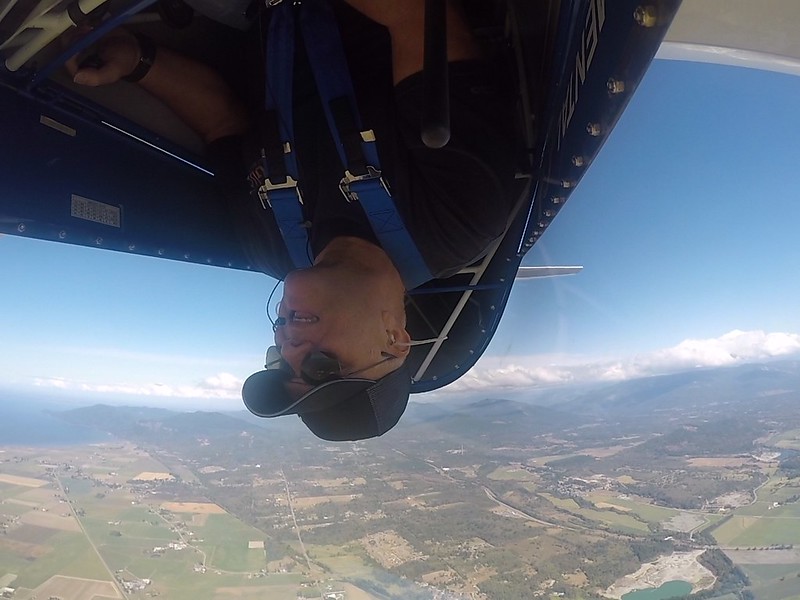My upset training
I took my Private Pilot training in the days when spins and recovery were required.
That was also the first year that the FAA required 45 minutes of under the hood instrument training.
My instructor was ‘just’ a CFI, but did have an Instrument rating, and was current.
He thought the FAA requirement was way overdue, and inadequate.
Shortly after the successful check ride, we did some upset recovery training in the Cessna 150, which included showing why diving back upright from inverted could not be safely done, rolling was the only viable option. GA aircraft are quite slippery, and accelerate rapidly in dives.
To prove the failure of diving through, we set cruise power and speed, then firmly pushed the nose down 60 degrees, and immediately pulled back to level, estimating 2 G’s. The airspeed went into the yellow arc before we reached level flight. It was obvious that if you pulled back from inverted, going to a straight down dive, and continued to pull back at a survivable G force, the red line would be exceeded by a large margin. No hope diving through.
We then caged the gyro horizon, rolled to 90 degrees, and rolled back to wings level. The nose had dropped some, but moderate back pressure and less than 2 G’s had us level again. The second try, we went beyond 90, and as the wings were rolled level, no back pressure was applied to the yoke, and the plane returned to the speed it had been trimmed to before the roll. Again, we remained within the green arc.
The big lesson that he was teaching me was that the only reaction that could win was a roll back to wings level.
Figuring out which way to roll is the harder problem in a really bad upset, but rolling is the only response that should be considered.
The gyro horizon in that plane tumbled at around 80 degrees, so it was caged for that initial introduction to upset. Under the hood upsets to less than 80 degrees, with disorienting swerves and skids were then conducted, using the horizon as primary source for pitch and bank.
Modern electric and electronic horizons may not tumble, and provide accurate information in all attitudes, so will be much more useful that what I was using back then.
Later, I took an hour of aerobatic training in a Cessna 150 Aerobat. In that plane, I learned firsthand that even going over the top of a loop at near stall speed, and pulling more than 2 G’s in the dive; you flirted with the yellow arc. Even in that plane, diving through from 90K or faster would have been a high risk maneuver.
Rolling inverted at cruise speed, and allowing the nose to drop 30 degrees, rolling back upright was a trivial event, and did not come close to the yellow arc.
I have experienced wake turbulence twice. Flying safety pilot for another pilot who was under the hood, we flew under the track of an airliner inbound to KBWI, and pretty far behind it. The upset was both roll and pitch, and I hit my head against the overhead, with my seatbelt tight. The other pilot was shorter, and did not bump his head. His response was correct, wings level, correct the pitch, and recover assigned altitude. We were below a thin layer, VFR, and the airliners were above it, we never saw them. We did go to a different area to continue the hood work.
The second time, clear air, no clouds anywhere, and flew through a vortex about10 miles from Richmond VA. We never saw the plane, but the partial upset was quite high G force. Recovery was trivial in severe VFR, but in instrument conditions, the gyro would have been nice for the first reaction.
An upset resulting from wake turbulence is probably the most likely one that we might experience, as outside the approach and departure phases of flight, they are near impossible to anticipate, and exist everywhere. Simply following a Victor or GPS route can take you through the track of a climbing or descending heavy, and “presto” you are in the rolling air.
Upset recovery training should take place in aircraft as similar to our normal plane as possible, so that we are flying the actual responses, and limitations that we have to live with when our upset occurs
Aerobatics, by the way, are fantastic fun, even in a lowly Cessna 150 Aerobat!
Edited to add:
Training in a simulator, with or without motion, is an excellent tool. That will bring you to understand the rapidity of acceleration in nose down attitudes, as well as the speed with which rolls to upright take place. They also require total dependence on the instruments, not your sensations. That is a key item, as instrument failure is unlikely to occur just as the plane goes awry. Unless you were on autopilot.


